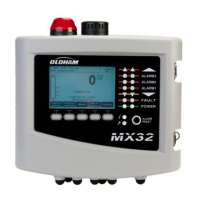Calibration
Gas detectors are safety devices. Accordingly, OLDHAM recommends regular
testing of fixed gas detection installations. This type of test consists of
injecting a standard gas of sufficient concentration into the sensor to set off
the pre-adjusted alarms. This test does not, in any event, replace a full
calibration of the sensor.
Frequency of gas testing depends on the industrial application in which the
sensors are used. Inspection should occur frequently during the months
following installation start up, later it may be spaced out if no significant
problem is observed.
If a detector does not react upon contact with gas, it must be
calibrated. Calibration frequency should be adapted based
on test results. However, it should not be greater than one
year.
Safety Procedures
The site manager is responsible for implementing the safety procedures on
his site. Oldham is not responsible for implementing safety procedures.
■ Refer to the Menu Initialization paragraphs (page 23).
■ Do not forget to complete a system start-up after changing the sensor by
using the "INI" menu (Menu Initialization (INI) paragraph, on page 23).
Fuse replacement
Replacement of the fuses should only be performed by a qualified
professional. The fuses in use must conform to CEI 127 regulations (time-
delayed, low breaking capacity, 250 V AC power source). Please see the
following paragraph.
Parts
Fuse F7 (2 A T, 250 V AC) – Versions 115 or 230 V AC.
Fuse F8 (315 mA T, 250 V AC) – Version 115 V AC.
Fuse F8 (160 mA T, 250 V AC) – Version 230 V AC.
Fuse F9 (315 mA T, 250 V AC) – Version 115 V AC.
Fuse F9 (160 mA T, 250 V AC) – Version 230 V AC.
Fuse F11 (630 mA T, 250 V AC).
Fuse F13 (630 mA T, 250 V AC).
Programming strip 4-20 mA
Single channel analog card

